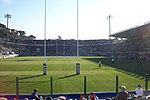Battle of the Milvian Bridge

The Battle of the Milvian Bridge took place between the Roman Emperors Constantine I and Maxentius on 28 October 312. It takes its name from the Milvian Bridge, an important route over the Tiber. Constantine won the battle and started on the path that led him to end the Tetrarchy and become the sole ruler of the Roman Empire. Maxentius drowned in the Tiber during the battle; his body was later taken from the river and decapitated, and his head was paraded through the streets of Rome on the day following the battle before being taken to Africa.According to Christian chroniclers Eusebius of Caesarea and Lactantius, the battle marked the beginning of Constantine's conversion to Christianity. Eusebius of Caesarea recounts that Constantine and his soldiers had a vision sent by the Christian God. This was interpreted as a promise of victory if the sign of the Chi Rho, the first two letters of Christ's name in Greek, was painted on the soldiers' shields. The Arch of Constantine, erected in celebration of the victory, certainly attributes Constantine's success to divine intervention; however, the monument does not display any overtly Christian symbolism.
Excerpt from the Wikipedia article Battle of the Milvian Bridge (License: CC BY-SA 3.0, Authors, Images).Battle of the Milvian Bridge
Milvian Bridge, Rome Tor di Quinto
Geographical coordinates (GPS) Address Nearby Places Show on map
Geographical coordinates (GPS)
| Latitude | Longitude |
|---|---|
| N 41.935555555556 ° | E 12.466944444444 ° |
Address
Ponte Milvio
Milvian Bridge
00194 Rome, Tor di Quinto
Lazio, Italy
Open on Google Maps










